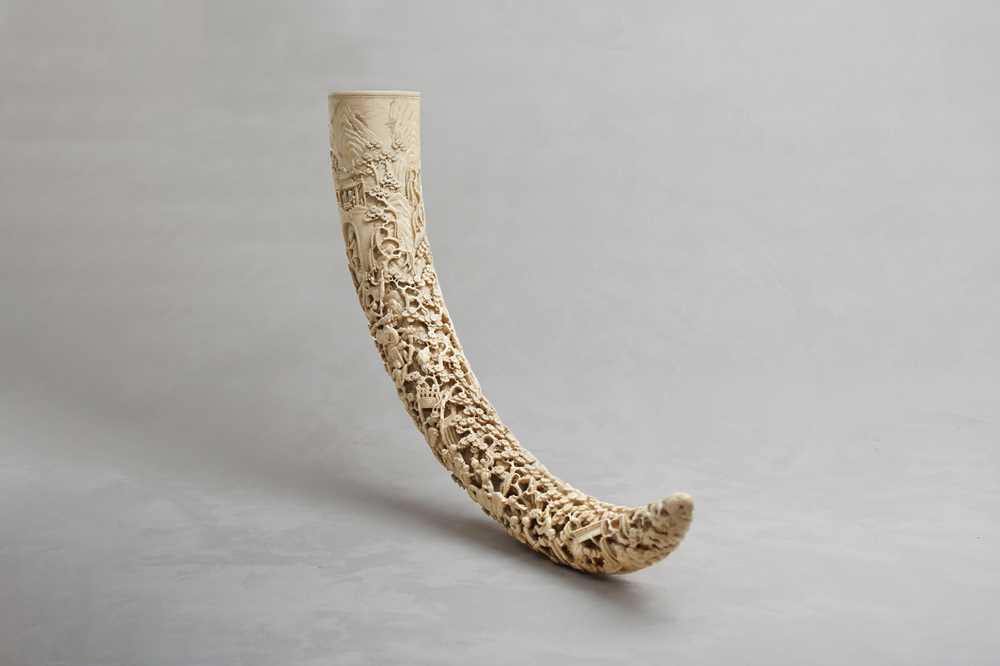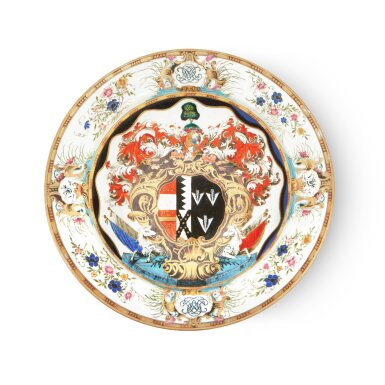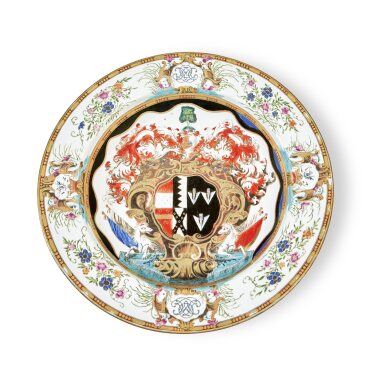An impressive Chinese Qing dynasty gilt bronze and enamel musical automaton table clock Unsigned, probably Guangzhou or Yangzhou workshops, circa 1800 The substantial five knopped pillar triple chain fusee movement with verge escapement regulated by short bob pendulum, striking the hour on a single large bell and playing a tune via a pinned cylinder and eleven hammers on a graduated nest of eleven bells every hour whilst consecutively driving the automata features in both the arch of the dial and case superstructure, the backplate engraved with delicate symmetrical foliage around a central oval cartouche, the 7.5 inch arched dial incorporating convex circular Roman numeral enamel centre with heart-pierced brass hands and Arabic quarters to outer track, the spandrel areas with dark cobalt blue ground floral spray enamel panel infill within bright-cut gilt brass frame borders, the arch inset with finely painted polychrome layered fretwork landscape incorporating trees and pavilions and a parading serials of figures and animals including elephants with nine-rod spinning glass ‘waterfall’ behind, the case with elaborate superstructure modelled as an octagonal pagoda with concave roof sections enamelled with repeating polychrome and gilt stylised flower motifs on a cobalt blue ground divided by foliate cast and chased ridges, the frieze decorated with drapery swags and flowerheads above arched apertures with beaded surrounds flanked by column uprights at the angles, enclosing interior with central elevated polychrome painted ivory figure of Shou-lao holding the gourd containing the elixir of life in his left hand which he raises and lowers in time with the strike of the hour bell, around him are seven further figures set-down on a ring which rotates whilst the music is sounding, the whole raised on a concave-sided platform with baluster gallery over ribbon-tied laurel crest and repeating floral motif cast arched bevel-glazed front door, the waisted sides with beaded front angles and applied with conforming blue enamel ground oval panels within fine foliate cast and chased surrounds, the rear with arched door, on generous paw cast feet with twin floral festoon cast mount to front apron between, 71cm (28ins) high, 33cm (13ins) wide and 21cm (8.25ins) deep. Provenance: The beneficiary of a private collection, Isle of Man. The Chinese pre-occupation with mechanical timepieces can trace its roots back to the Court of the Wanli emperor who received as a gift two timepieces from the Jesuit priest Matteo Ricci in 1601. During the 18th century (from the Kangxi reign onwards) exotic musical automaton timepieces became highly desirable and thus a very important commodity with regards to maintaining healthy trade relations between London and the Chinese Court. By the time of the reign of the Qianlong emperor such examples of the clockmaking art had become so fashionable that they were traded often as gifts to imminent officials and wealthy merchants as well as the Court itself. Mechanical clocks also had symbolic purpose to the emperor signifying the ability to master the time and the calendar. As such they cemented his position as the Son of Heaven of having divine powers and the ability to control the transcendence of time in the universe. Clocks were also valued for their practical applications and symbolised the smooth running of the emperor’s administration through efficient time management. This significance is perfectly illustrated by a poem composed by the Kangxi emperor titled 'The Chanting of the Chiming Clock', which translates as: 'Methods originating from the West, taught us with a keen heart. Wheels circle on a quarterly basis, hands move according to minutes. Dawn needs not to be announced, golden clock reports in advance. Work hard on government affairs in the morning, memorials are never completed in a late manner.' The Qianlong emperor inherited passion for science and technology from his great grandfather and his court conti
An impressive Chinese Qing dynasty gilt bronze and enamel musical automaton table clock Unsigned, probably Guangzhou or Yangzhou workshops, circa 1800 The substantial five knopped pillar triple chain fusee movement with verge escapement regulated by short bob pendulum, striking the hour on a single large bell and playing a tune via a pinned cylinder and eleven hammers on a graduated nest of eleven bells every hour whilst consecutively driving the automata features in both the arch of the dial and case superstructure, the backplate engraved with delicate symmetrical foliage around a central oval cartouche, the 7.5 inch arched dial incorporating convex circular Roman numeral enamel centre with heart-pierced brass hands and Arabic quarters to outer track, the spandrel areas with dark cobalt blue ground floral spray enamel panel infill within bright-cut gilt brass frame borders, the arch inset with finely painted polychrome layered fretwork landscape incorporating trees and pavilions and a parading serials of figures and animals including elephants with nine-rod spinning glass ‘waterfall’ behind, the case with elaborate superstructure modelled as an octagonal pagoda with concave roof sections enamelled with repeating polychrome and gilt stylised flower motifs on a cobalt blue ground divided by foliate cast and chased ridges, the frieze decorated with drapery swags and flowerheads above arched apertures with beaded surrounds flanked by column uprights at the angles, enclosing interior with central elevated polychrome painted ivory figure of Shou-lao holding the gourd containing the elixir of life in his left hand which he raises and lowers in time with the strike of the hour bell, around him are seven further figures set-down on a ring which rotates whilst the music is sounding, the whole raised on a concave-sided platform with baluster gallery over ribbon-tied laurel crest and repeating floral motif cast arched bevel-glazed front door, the waisted sides with beaded front angles and applied with conforming blue enamel ground oval panels within fine foliate cast and chased surrounds, the rear with arched door, on generous paw cast feet with twin floral festoon cast mount to front apron between, 71cm (28ins) high, 33cm (13ins) wide and 21cm (8.25ins) deep. Provenance: The beneficiary of a private collection, Isle of Man. The Chinese pre-occupation with mechanical timepieces can trace its roots back to the Court of the Wanli emperor who received as a gift two timepieces from the Jesuit priest Matteo Ricci in 1601. During the 18th century (from the Kangxi reign onwards) exotic musical automaton timepieces became highly desirable and thus a very important commodity with regards to maintaining healthy trade relations between London and the Chinese Court. By the time of the reign of the Qianlong emperor such examples of the clockmaking art had become so fashionable that they were traded often as gifts to imminent officials and wealthy merchants as well as the Court itself. Mechanical clocks also had symbolic purpose to the emperor signifying the ability to master the time and the calendar. As such they cemented his position as the Son of Heaven of having divine powers and the ability to control the transcendence of time in the universe. Clocks were also valued for their practical applications and symbolised the smooth running of the emperor’s administration through efficient time management. This significance is perfectly illustrated by a poem composed by the Kangxi emperor titled 'The Chanting of the Chiming Clock', which translates as: 'Methods originating from the West, taught us with a keen heart. Wheels circle on a quarterly basis, hands move according to minutes. Dawn needs not to be announced, golden clock reports in advance. Work hard on government affairs in the morning, memorials are never completed in a late manner.' The Qianlong emperor inherited passion for science and technology from his great grandfather and his court conti











Try LotSearch and its premium features for 7 days - without any costs!
Be notified automatically about new items in upcoming auctions.
Create an alert